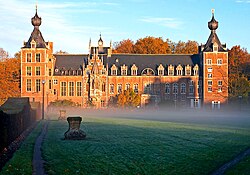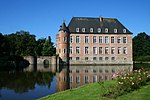Château of Arenberg: Difference between revisions
No edit summary |
Jason Lagos (talk | contribs) |
||
| (110 intermediate revisions by 70 users not shown) | |||
| Line 1: | Line 1: | ||
{{Short description|Château in Heverlee, Belgium}} |
|||
[[Image:Castle Arenberg, Katholieke Universiteit Leuven.jpg|thumb|Castle Arenberg]] |
|||
{{Distinguish|text=the [[Arenberg Castle, Salzburg|Arenberg Castle]] in [[Salzburg]] or the Napoleonic chateau of [[Arenenberg]]}} |
|||
Castle [[Arenberg]] is built on the exact spot where there was once a 12th century water castle. Antoon Van Croy demolished that old castle except for one tower and replaced it by the current castle, which was finished in 1515. His grandson was responsible for the beautiful park around the castle. There were some minor alterations done throughout the centuries but the castle kept pretty much it original looks. |
|||
{{Refimprove|date=January 2023}} |
|||
{{Use British English|date=January 2023}} |
|||
{{Use dmy dates|date=January 2023}} |
|||
{{Infobox building |
|||
| name = Château of Arenberg |
|||
| native_name = {{unbulleted list|{{native name|nl|Kasteel van Arenberg}}|{{native name|fr|Château d'Arenberg}}}} |
|||
| former_names = |
|||
| alternate_names = |
|||
| image = Castle Arenberg, Katholieke Universiteit Leuven adj.jpg |
|||
| image_alt = |
|||
| image_size = |
|||
| caption = Château of Arenberg |
|||
| map_type = |
|||
| map_alt = |
|||
| map_caption = |
|||
| map_dot_label = |
|||
| address = |
|||
| location_town = [[Heverlee]], [[Flemish Brabant]] |
|||
| location_country = Belgium |
|||
| coordinates = {{coord|50|51|48|N|4|40|59|E|type:landmark_region:BE|display=inline,title}} |
|||
| building_type = [[Château]] |
|||
| architectural_style = [[Renaissance architecture|Flemish Renaissance]] |
|||
| structural_system = |
|||
| cost = |
|||
| client = |
|||
| owner = |
|||
| current_tenants = |
|||
| landlord = |
|||
| start_date = |
|||
| completion_date = |
|||
| inauguration_date = |
|||
| renovation_date = |
|||
| demolition_date = |
|||
| destruction_date = |
|||
| reconstruction_date = |
|||
| height = |
|||
| diameter = |
|||
| altitude = |
|||
| other_dimensions = |
|||
| floor_count = |
|||
| floor_area = |
|||
| main_contractor = |
|||
| architect = |
|||
| architecture_firm = |
|||
| structural_engineer = |
|||
| services_engineer = |
|||
| civil_engineer = |
|||
| other_designers = |
|||
| quantity_surveyor = |
|||
| awards = |
|||
| designations = |
|||
| known_for = |
|||
| ren_cost = |
|||
| ren_architect = |
|||
| ren_firm = |
|||
| ren_str_engineer = |
|||
| ren_serv_engineer = |
|||
| ren_civ_engineer = |
|||
| ren_oth_designers = |
|||
| ren_qty_surveyor = |
|||
| ren_awards = |
|||
| parking = |
|||
| public_transit = |
|||
| website = |
|||
| references = |
|||
}} |
|||
The '''Château of Arenberg''' or '''Arenberg Castle'''<ref>{{Cite web |date=2016-11-23 |title=Arenberg Castle & Park {{!}} Visit Leuven |url=https://www.visitleuven.be/en/arenberg-castle |access-date=2023-01-19 |website=www.visitleuven.be |language=en-GB}}</ref><ref>{{Cite web |title=Arenberg Castle |url=https://www.toerismevlaamsbrabant.be/en/producten/bezoeken/bezienswaardigheden/arenbergkasteel/en/producten/bezoeken/bezienswaardigheden/arenbergkasteel/ |access-date=2023-01-19 |website=www.toerismevlaamsbrabant.be |language=en}}</ref> ({{lang-nl|Kasteel van Arenberg}}; {{lang-fr|Château d'Arenberg}}) is a [[Renaissance architecture|Flemish Renaissance]] style [[château]] in [[Heverlee]], close to [[Leuven]], Belgium. It is surrounded by a park. |
|||
The first [[theatre]] of Belgium was founded in the castle in 1616. [[Voltaire]] was often a guest in the castle. On November 21st, 1783 Professor Jan-Pieter Minckeler’s took off for the first time in history with a gas filled balloon from the front lawn of the castle. The castle is now property of the University of Leuven. You can walk freely in the park and through the gate into the courtyard of the castle. Close to the castle are a couple of taverns where you can get some yummy ice cream :). Castle Arenberg is in Heverlee very close to [[Leuven]]. |
|||
{{wikify}} |
|||
Built in place of a 12th century medieval castle, the current château was started in the 16th century but still underwent many changes in the following centuries. In 1612, it passed into the hands of the [[House of Arenberg|Arenberg family]], who occupied it until the [[First World War]]. The building is now owned by the [[KU Leuven|Katholieke Universiteit Leuven]] (KU Leuven). |
|||
[[category:castles]] |
|||
==History== |
|||
[[File:Charles d'Arenberg and Anne de Croy with family by F.Pourbus Jr. (c.1593, Arenbergkasteel).jpg|thumb|''Charles d'Arenberg and Anne de Croy with family'', c. 1593, by [[Frans Pourbus the Younger]]]] |
|||
The site had been the castle of the lords of [[Heverlee]] since the 12th century, but this family became impoverished and had to sell the site in 1445 to the [[House of Croÿ|Croÿ family]] from [[Picardy]]. [[Antoon van Croy|Antoine I de Croÿ]] demolished the medieval castle and started works to build the current château in 1455 on the site, of which he destroyed all but one tower. His grandson, [[Willem van Croÿ|William de Croÿ]], completed the works on the château in 1515, and founded a monastery on the château grounds for the [[Benedictine]] [[Celestines]]. The architectural style is in large part traditionally Flemish, with sandstone window frames and brick walls, though it has been structurally altered since 1515 and has elements of [[Gothic architecture|Gothic]], [[Renaissance architecture|Renaissance]], and [[Neo-Gothic architecture|neo-Gothic]] architecture. Its large corner towers are typical, once surmounted by a German eagle. [[Charles III de Croÿ|Charles III of Croy]] was the 4th and last duke, and after his death in 1612 without issue, the château passed to the German [[House of Arenberg]] into which his sister had married, and remained in that family until the [[First World War]]. |
|||
Even before the First World War, the 8th duke of Arenberg wanted to sell the château and its grounds to the old [[Catholic University of Leuven (1834–1968)|Catholic University of Leuven]], for a reasonable price.{{Citation needed|date=July 2011}} During the war, the château and grounds were occupied by the Germans and Austrians. The château and park were seized by the Belgian Government on the outbreak of, and then after the war, since the Arenberg family was considered to be German or Austrian due to their close [[House of Habsburg|Habsburg]] connection, monarchs of [[Austria-Hungary]]. It took until 1921 for the University to acquire them, becoming an expanded natural sciences and engineering campus in the style of that of an American university. After the partitioning of the university along language lines in 1968, the château and grounds remained with the Dutch speaking half as one of the main campuses for the new, independent [[KU Leuven|Katholieke Universiteit Leuven]] (KU Leuven). The château itself is the main building of the Faculty of Engineering and houses lecture rooms and studios for the Department of Architecture, Urbanism and Urban Planning, including the Post-Graduate Centre Human Settlements and the Raymond Lemaire International Centre for Conservation (named after [[Raymond M. Lemaire]]). The building is open to the public. The former Celestine monastery on the château grounds now houses the campus library, and the addresses of many of the science buildings are on the street named ''Celestijnenlaan'' (Dutch for "Celestine Street"). |
|||
==See also== |
|||
{{Portal|Belgium}} |
|||
* [[List of castles and châteaux in Belgium]] |
|||
==References== |
|||
{{reflist}} |
|||
{{Commons category|Kasteel van Arenberg}} |
|||
==External links== |
|||
* [https://web.archive.org/web/20120627134710/http://www.leuven.be/en/tourism/sightseeing/university/kasteel-arenberg/index.jsp Local tourism information] |
|||
{{Universities of Louvain}}{{Castles in Belgium}} |
|||
[[Category:Castles in Belgium|Arenberg]] |
|||
[[Category:Castles in Flemish Brabant|Arenberg]] |
|||
[[Category:Buildings and structures in Leuven]] |
|||
[[Category:Arenberg family]] |
|||
Latest revision as of 08:52, 3 September 2024
This article needs additional citations for verification. (January 2023) |
| Château of Arenberg | |
|---|---|
 Château of Arenberg | |
 | |
| General information | |
| Type | Château |
| Architectural style | Flemish Renaissance |
| Town or city | Heverlee, Flemish Brabant |
| Country | Belgium |
| Coordinates | 50°51′48″N 4°40′59″E / 50.86333°N 4.68306°E |
The Château of Arenberg or Arenberg Castle[1][2] (Dutch: Kasteel van Arenberg; French: Château d'Arenberg) is a Flemish Renaissance style château in Heverlee, close to Leuven, Belgium. It is surrounded by a park.
Built in place of a 12th century medieval castle, the current château was started in the 16th century but still underwent many changes in the following centuries. In 1612, it passed into the hands of the Arenberg family, who occupied it until the First World War. The building is now owned by the Katholieke Universiteit Leuven (KU Leuven).
History
[edit]
The site had been the castle of the lords of Heverlee since the 12th century, but this family became impoverished and had to sell the site in 1445 to the Croÿ family from Picardy. Antoine I de Croÿ demolished the medieval castle and started works to build the current château in 1455 on the site, of which he destroyed all but one tower. His grandson, William de Croÿ, completed the works on the château in 1515, and founded a monastery on the château grounds for the Benedictine Celestines. The architectural style is in large part traditionally Flemish, with sandstone window frames and brick walls, though it has been structurally altered since 1515 and has elements of Gothic, Renaissance, and neo-Gothic architecture. Its large corner towers are typical, once surmounted by a German eagle. Charles III of Croy was the 4th and last duke, and after his death in 1612 without issue, the château passed to the German House of Arenberg into which his sister had married, and remained in that family until the First World War.
Even before the First World War, the 8th duke of Arenberg wanted to sell the château and its grounds to the old Catholic University of Leuven, for a reasonable price.[citation needed] During the war, the château and grounds were occupied by the Germans and Austrians. The château and park were seized by the Belgian Government on the outbreak of, and then after the war, since the Arenberg family was considered to be German or Austrian due to their close Habsburg connection, monarchs of Austria-Hungary. It took until 1921 for the University to acquire them, becoming an expanded natural sciences and engineering campus in the style of that of an American university. After the partitioning of the university along language lines in 1968, the château and grounds remained with the Dutch speaking half as one of the main campuses for the new, independent Katholieke Universiteit Leuven (KU Leuven). The château itself is the main building of the Faculty of Engineering and houses lecture rooms and studios for the Department of Architecture, Urbanism and Urban Planning, including the Post-Graduate Centre Human Settlements and the Raymond Lemaire International Centre for Conservation (named after Raymond M. Lemaire). The building is open to the public. The former Celestine monastery on the château grounds now houses the campus library, and the addresses of many of the science buildings are on the street named Celestijnenlaan (Dutch for "Celestine Street").
See also
[edit]References
[edit]- ^ "Arenberg Castle & Park | Visit Leuven". www.visitleuven.be. 23 November 2016. Retrieved 19 January 2023.
- ^ "Arenberg Castle". www.toerismevlaamsbrabant.be. Retrieved 19 January 2023.




